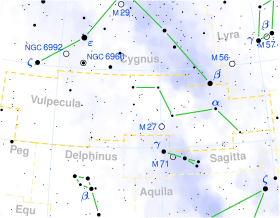23 Vulpeculae
| Observation data Epoch J2000 Equinox J2000 | |
|---|---|
| Constellation | Vulpecula |
| Right ascension | 20h 15m 46.13481s[1] |
| Declination | 27° 48′ 51.2787″[1] |
| Apparent magnitude (V) | 4.52[2] |
| Characteristics | |
| Spectral type | K3III Fe-1[3] |
| U−B color index | +1.11[2] |
| B−V color index | +1.26[2] |
| Astrometry | |
| Radial velocity (Rv) | +1.47[4] km/s |
| Proper motion (μ) | RA: -34.27[1] mas/yr Dec.: +6.41[1] mas/yr |
| Parallax (π) | 9.63 ± 0.46[1] mas |
| Distance | 340 ± 20 ly (104 ± 5 pc) |
| Absolute magnitude (MV) | -0.58[3] |
| Details | |
| Mass | 2.4[5] M☉ |
| Luminosity | 272[3] L☉ |
| Surface gravity (log g) | 0.89[6] cgs |
| Temperature | 4,429[7] K |
| Metallicity [Fe/H] | +0.03[3] dex |
| Rotational velocity (v sin i) | 3.7[8] km/s |
| Other designations | |
| Database references | |
| SIMBAD | data |
23 Vulpeculae is a class K3III[3] (orange giant) star in a triple star system in the constellation Vulpecula. Its apparent magnitude is 4.52[2] and it is approximately 339 light years away based on parallax.[1] It has two reported companions; Ab has a separation of 0.11", a magnitude of 6.5, and a period of about 25 years, while B has a separation of 0.26" and a magnitude of 6.94.[5][9][10]
References
- 1 2 3 4 5 6 Van Leeuwen, F. (2007). "Validation of the new Hipparcos reduction". Astronomy and Astrophysics. 474 (2): 653. arXiv:0708.1752
 . Bibcode:2007A&A...474..653V. doi:10.1051/0004-6361:20078357. Vizier catalog entry
. Bibcode:2007A&A...474..653V. doi:10.1051/0004-6361:20078357. Vizier catalog entry - 1 2 3 4 Ducati, J. R. (2002). "VizieR Online Data Catalog: Catalogue of Stellar Photometry in Johnson's 11-color system". CDS/ADC Collection of Electronic Catalogues. 2237. Bibcode:2002yCat.2237....0D.
- 1 2 3 4 5 Anderson, E.; Francis, Ch. (2012). "XHIP: An extended hipparcos compilation". Astronomy Letters. 38 (5): 331. arXiv:1108.4971
 . Bibcode:2012AstL...38..331A. doi:10.1134/S1063773712050015. Vizier catalog entry
. Bibcode:2012AstL...38..331A. doi:10.1134/S1063773712050015. Vizier catalog entry - ↑ Famaey, B.; Jorissen, A.; Luri, X.; Mayor, M.; Udry, S.; Dejonghe, H.; Turon, C. (2005). "Local kinematics of K and M giants from CORAVEL/Hipparcos/Tycho-2 data". Astronomy & Astrophysics. 430: 165. arXiv:astro-ph/0409579
 . Bibcode:2005A&A...430..165F. doi:10.1051/0004-6361:20041272.
. Bibcode:2005A&A...430..165F. doi:10.1051/0004-6361:20041272. - 1 2 Malkov, O. Yu.; Tamazian, V. S.; Docobo, J. A.; Chulkov, D. A. (2012). "Dynamical masses of a selected sample of orbital binaries". Astronomy & Astrophysics. 546: A69. Bibcode:2012A&A...546A..69M. doi:10.1051/0004-6361/201219774. Vizier catalog entry
- ↑ Soubiran, Caroline; Le Campion, Jean-François; Brouillet, Nathalie; Chemin, Laurent (2016). "The PASTEL catalogue: 2016 version". Astronomy & Astrophysics. 591: A118. arXiv:1605.07384
 . Bibcode:2016A&A...591A.118S. doi:10.1051/0004-6361/201628497.
. Bibcode:2016A&A...591A.118S. doi:10.1051/0004-6361/201628497. - ↑ McDonald, I.; Zijlstra, A. A.; Boyer, M. L. (2012). "Fundamental parameters and infrared excesses of Hipparcos stars". Monthly Notices of the Royal Astronomical Society. 427: 343. Bibcode:2012MNRAS.427..343M. doi:10.1111/j.1365-2966.2012.21873.x. Vizier catalog entry
- ↑ De Medeiros, J. R.; Mayor, M. (1999). "A catalog of rotational and radial velocities for evolved stars". Astronomy and Astrophysics Supplement Series. 139 (3): 433. Bibcode:1999A&AS..139..433D. doi:10.1051/aas:1999401. Vizier catalog entry
- ↑ Mason, Brian D.; Wycoff, Gary L.; Hartkopf, William I.; Douglass, Geoffrey G.; Worley, Charles E. (2001). "The 2001 US Naval Observatory Double Star CD-ROM. I. The Washington Double Star Catalog". The Astronomical Journal. 122 (6): 3466. Bibcode:2001AJ....122.3466M. doi:10.1086/323920. Vizier catalog entry
- ↑ Eggleton, P. P.; Tokovinin, A. A. (2008). "A catalogue of multiplicity among bright stellar systems". Monthly Notices of the Royal Astronomical Society. 389 (2): 869. arXiv:0806.2878
 . Bibcode:2008MNRAS.389..869E. doi:10.1111/j.1365-2966.2008.13596.x. Vizier catalog entry
. Bibcode:2008MNRAS.389..869E. doi:10.1111/j.1365-2966.2008.13596.x. Vizier catalog entry
External links
- 23 Vulpeculae on WikiSky: DSS2, SDSS, GALEX, IRAS, Hydrogen α, X-Ray, Astrophoto, Sky Map, Articles and images
This article is issued from Wikipedia - version of the 9/1/2016. The text is available under the Creative Commons Attribution/Share Alike but additional terms may apply for the media files.
